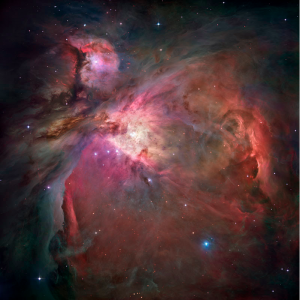This year my son and I decided to use a new and unusual history curriculum in our homeschool. The Big History Project is an attempt to reshape history to be meaningful to kids in the age of information. Rather than focusing just on the wars and conquests of the past, this curriculum attempts to help students understand a context for human history and make sense of their place in it.
One of the first concepts Big History covers is the question of scale. What does it mean to be human in an unfathomably huge and ancient universe? What is our role as a species? What is the importance of the individual and of our achievements?

I was thinking about how to represent this in a way that makes sense to me. I think a lot about what it means for a human consciousness to be trapped inside a biological body. Our consciousness is so vast—unlike (as far as we know) other animals, we can conceive of the universe. We can imagine a million years into the future or the past. We can study fossils and recreate the life they lived in words, static art, and film.
This vastness of our consciousness leads us, however, to have difficulty in placing our lives in context. Especially when we are children, what’s happening in our heads naturally feels as if it’s the center of things. One of the most fascinating parts of being a parent for me was watching my children define who they are within their own bodies.
First, you have a baby who has only recently separated from being part of someone else’s body. The baby has a desperate need to be touched, as if that little consciousness can’t yet conceive of being its own person. I remember with both of my babies the day they pulled their heads back from nursing and looked up at me with a new curiosity—Hello! Who are you? Who am I?
Then the baby starts to look and move around. Everything in the baby’s life revolves around the baby. Having siblings perhaps makes it a little easier to sense that you’re not the center of the universe, but your needs are still very selfish—throughout the toddler years and for some kids, well into childhood, there is a selfishness in fulfilling desires and satisfying needs. Babies don’t ask, “Is it right that my mother has to drop everything to feed me?” Toddlers don’t ask, “Is this a convenient time for me to throw a tantrum?”
I see the primary years as the time when kids are negotiating these questions: Where do I leave off and other people begin? What rights do other people have over me? What right do I have to influence and involve other people? They start to learn by trial and error (and sometimes with adult help!) how far their consciousness extends and how much they are able to influence the world around them. During this time, kids start to comprehend the true scale of things and realize that their consciousness, though vast, is just one of billions.
And then the teen years. So many parents have trouble dealing with this time when their kids seem to take antagonistic positions just to prove that they are separate, autonomous beings. I agree that it’s hard, but it’s also a thrill to watch a child fully separate and develop into his own person, to start to understand his own consciousness and what he wants to do in this frustratingly brief turn we all get. A successful end to the teen years, it seems to me, is one in which the new adult is prepared to harness the vast consciousness to pursue goals within the limits of her human life. I know that I didn’t end my teens this way, but I hope I can guide my children as well as I can toward that understanding as their eventual goal.
If you’re interested in exploring the topic of scale, here are some cool resources we’ve used:
- This site shows a human form in relation to other objects as the user zooms in and out
- This one explores the concept of human perception of time in a visual schema
- This video from the Hubble Telescope is a fabulous example of how humans can lack a comprehension of the universe, mistaking a grain of sand-sized spot in our night sky as “empty”
- And of course you can’t talk about scale without viewing the classic Powers of Ten video
Comments
2 responses to “A question of scale”
I loved the links on scale – fascinating. Thanks – Amy
Hadn’t known about the “Big History Project,” Suki. Thanks. Razel